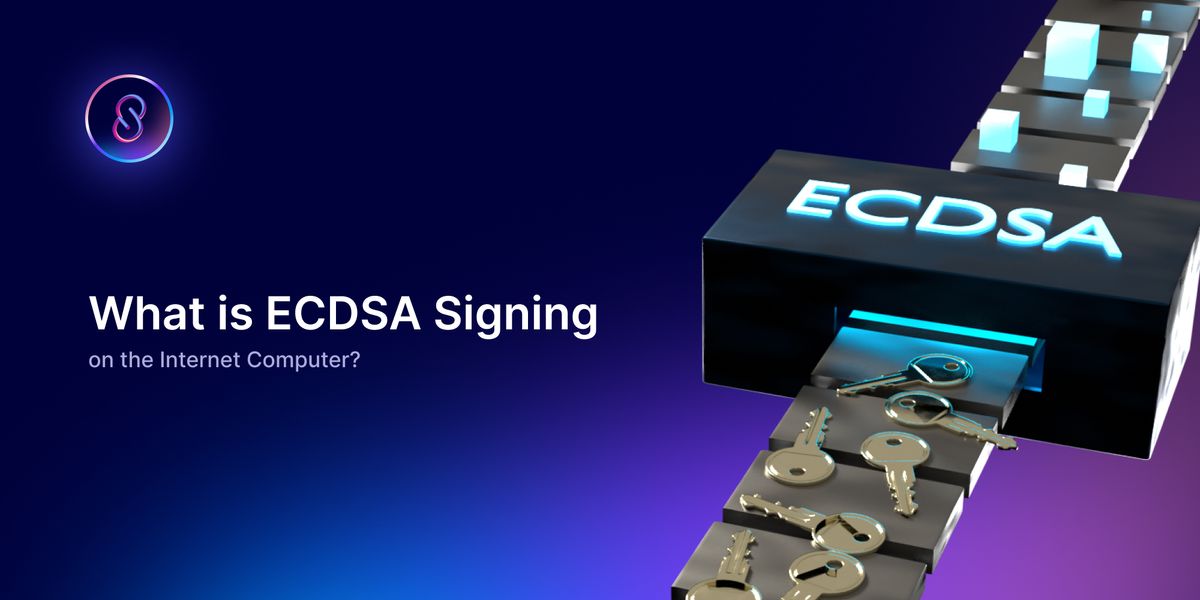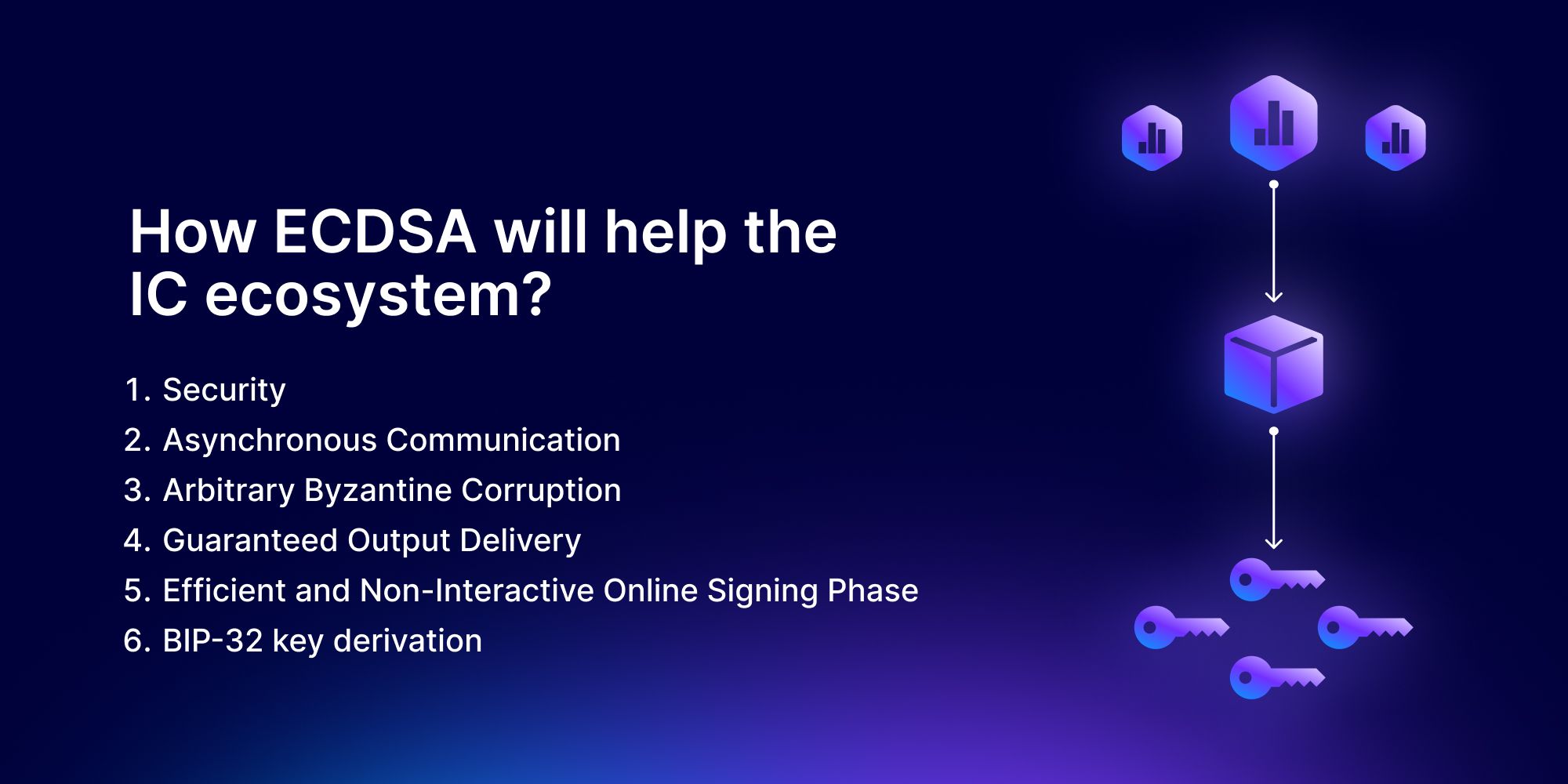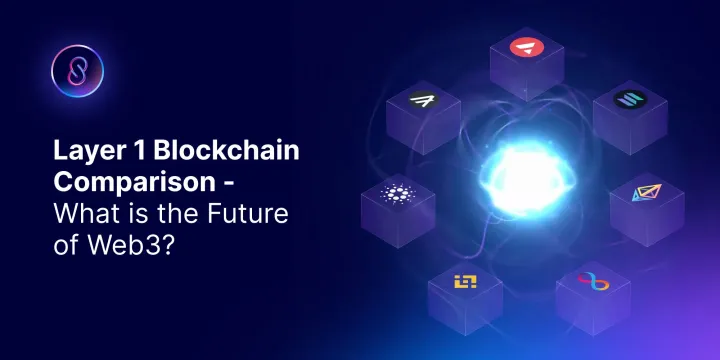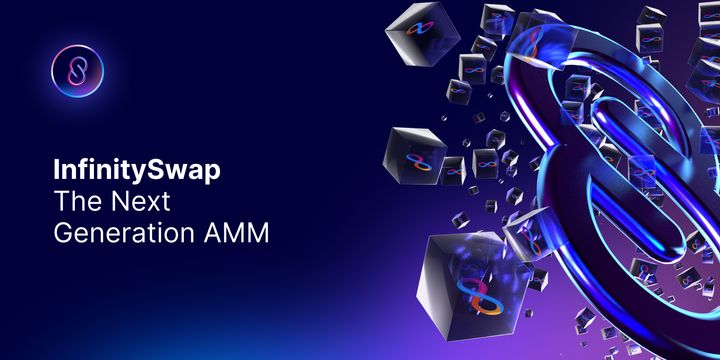What is ECDSA Signing on the Internet Computer?
ECDSA is widely used across many security systems, is in widespread use among messaging apps, and is the basis of Bitcoin Security.

What is ECDSA?
ECDSA stands for Elliptic Curve Digital Signature Algorithm. It is a combination of the Digital Signature Algorithm (DSA) and Elliptic Curve Cryptography (ECC). The DSA uses the keys derived from the ECC and is a very efficient equation based on Public Key Cryptography (PKC). ECDSA is widely used across many security systems, is in widespread use among messaging apps, and is the basis of Bitcoin Security.
ECDSA is also used for Transport Layer Security (TLS), by providing encryption to connections between web browsers and web applications. The main feature of ECDSA versus other popular algorithms like RSA is that it allows for a higher level of security with very short key lengths. This is very beneficial as it increases the ROI further as ECDSA uses fewer computing resources and is more secure.
Why ECDSA?
The Internet Computer has an innovative approach to direct integrations that allows a decentralized blockchain to directly authenticate and interact with other blockchains and systems without relying on external intermediaries. Other cross-chain solutions rely on Oracles, Bridges, and other custodial services that involve points of failure, whereas the Internet Computer aims to enable Blockchain integrations with the strongest possible trust properties thanks to the absence of additional trusted parties.
Recently, the Research and Development team at DFINITY announced how Internet Computer plans to integrate with Bitcoin, Ethereum, and other Blockchains by designing a new protocol for the threshold ECDSA. The innovative design plans to bring a trustless way of computing ECDSA signatures using a cryptographic multi-party protocol, with canister smart contracts controlling the ECDSA signing keys on a public blockchain.
Prior to the initiation of this integration, the Internet Computer used a distributed signing protocol based on a signature scheme called BLS, which is named after its inventors, Dan Boneh, Benn Lynn (now at DFINITY), and Hovav Shacham. The main reason behind choosing BLS was that it was much simpler to implement and a much more efficient distributed signing protocol compared to any other signature schemes.
However, other Blockchains like Bitcoin do not use BLS, instead they use the ECDSA scheme. Thus, to support integrations with other Blockchains like Bitcoin, Ethereum, etc. the Internet Computer adopted a proposal to implement a distributed ECDSA signing protocol on the Internet Computer.
How it will help the Internet Computer ecosystem?
Here are some of the key features of the new distributed ECDSA signing protocol:
- It guarantees security, meaning that the only signatures an adversary can obtain are those that are requested by honest replicas.
- Other than its reliance on the Internet Computer’s underlying consensus protocol, it works under the very weak assumption of asynchronous communication, meaning that it does not assume any a priori upper bound on the time required to deliver protocol messages.
- It works assuming that less than a third of the replicas are corrupt — this means arbitrary Byzantine corruption.
- It provides guaranteed output delivery, meaning that all signing requests will be fulfilled and the resulting signatures will be delivered to the honest replicas (to the extent that all messages between honest replicas are eventually delivered, and the consensus subprotocol provides liveness).
- It provides a very efficient, non-interactive online signing phase, meaning that assuming an appropriate message-independent precomputation, in response to a signing request, each replica simply broadcasts one “signature share”, and collects sufficiently many such “signature shares” to then compute the signature; in particular, the (more expensive) consensus subprotocol is not needed in the online signing phase.
- It supports BIP32-style additive key derivation, which means that many signing keys can be easily derived from a single signing key in a hierarchical fashion.

The introduction of these innovations on the Internet Computer is making it possible for developers to build Dapps and DeFi projects that at their core use the largest and the most adopted cryptocurrency in the world, leveraging immense value and bringing advanced smart contracts to Bitcoin.
DeFi projects like ours, InfinitySwap are already developing protocols based on lending, borrowing and also also exchanges that directly involve Bitcoin. ECDSA also hopes to lay the foundation for more research on the integration with other cryptocurrencies like Ethereum in the coming future and unlock a wide variety of use cases for the Internet Computer.
Connect with InfinitySwap
Twitter | Website | Telegram | Discord | Github

*Disclaimer: While every effort is made on this website to provide accurate information, any opinions expressed or information disseminated do not necessarily reflect the views of InfinitySwap itself.





Comments ()